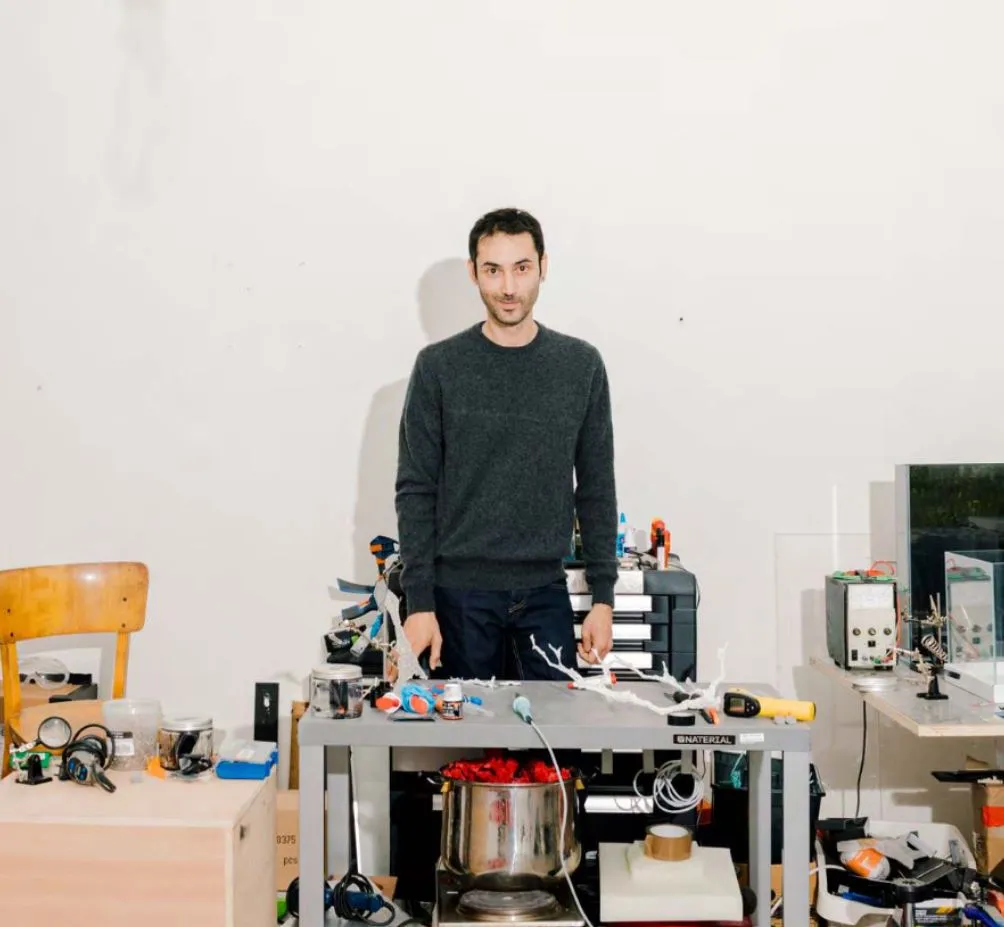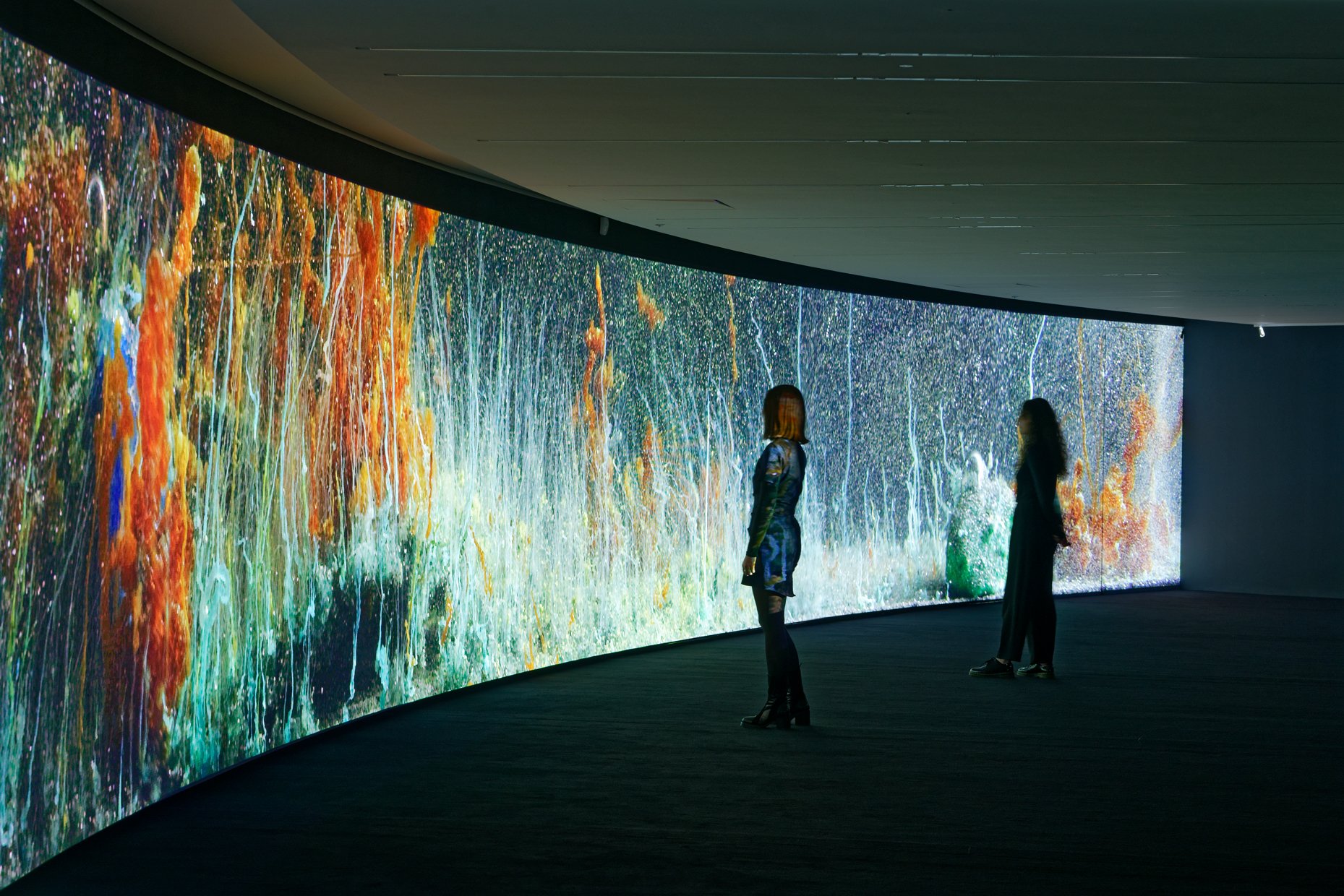
“A storm depends on where you see it from, whether you are afraid, or whether you are dazzled by its beauty”. Hicham Berrada
As part of the exhibition Avant l'orage at the Bourse de Commerce — Pinault Collection, Hicham Berrada presented his piece "Présage".
What experience do you want a visitor to have when they discover this piece?
It’s a video from the Présage series that I began about twelve years ago now. It consists of the appearance of a landscape in a container, a jar, or an aquarium. I generally deal with landscapes in my work, and by this term I mean thinking about our place in nature as humans, or the place we think we occupy. I hope that each visitor will have a different experience that is unique to them, in function of the landscapes they have seen beforehand and the things that they are thinking about at that time. I want this installation to be a kind of projection surface so that people can sit down, take the time to watch, and, in a way, to think of something else.
Are you inspired by science? Is the jar a painting, and the precipitate a colour palette?
It’s a little bit painting and a little bit chemistry, but it’s not really painting or chemistry either.
What interests me is using the scientific method, which for me is actually a kind of attitude. It’s also about observing a natural phenomenon, about noticing, being able to change a parameter and continuing to observe, to notice, and bit by bit, approaching one’s subject and getting to know it better. This method lets me take action, involve myself with the products I use and to familiarise myself with them, not necessarily to be able to manipulate them, but to push them to create something pictorial, that approaches the idea of painting. Most importantly, you are never looking at a fixed image, rather at a moving image. In a way, this is a painting of a landscape in motion. It doesn’t have a final image, instead forms that become, that make themselves. More than witnessing an image, what interests me is watching the creation and metamorphosis of an image. This is closer to the experience we have of a landscape when we look at it long enough, as the clouds move and the light changes. If you look at a landscape you love in different seasons, the leaves are not the same. Streams can dwindle, the flora and fauna can change, but it’s still the same landscape, the same place.
You are captivated by the fleeting quality of nature. Why?
I think there is something very poetic about certain forms and things, such as the aromas that nature creates, or the colours that are often highly ephemeral, like those of a flower. And it is often this fragility in what nature makes that I find to be very elegant. I am also fascinated by the creative genius of nature and the wealth of its shapes, be it in terms of forms or the aromas, colours, and light it creates. I often try to create “hand in hand” with nature instead of starting from scratch. I instead observe natural phenomena the way painters observed nature to represent it, and I try to understand thoroughly what is happening in terms of the materials.
Why are human beings absent from your works?
The human element is never present. It is present in that there are exhibitions, within the exhibition space, as long as humans look at the work being shown.
I like working with timeframes and senses of scale that are totally different from our own, to access realities that we usually don’t attain. I am interested in this ambivalence. I like when there isn’t anything to hang onto in terms of time or scale. This way, people watching don’t have anything to hang onto or that they know well; this provokes a floating sensation, as well as a kind of visionary ability. When you are in uncertain terrain, you are in a way more open to projecting things than when you clearly recognise a size, a scale, or a person’s face. Everyone is thus able to go to an elsewhere, one that is nevertheless unique to them.
Aquaria and terraria recur frequently in your works. What purpose do they serve?
The containers I use are, first and foremost, a necessity. An aquarium or a terrarium (ultimately these are just boxes with different properties) are necessary for controlling the conditions within them. Nature is a space of infinite dimensions. I instead need to take an element from nature and to bring it back to my studio, and in my studio, to put it in a box or a place in which the dimensions will not change. Having a certain stability to the framework then allows me to appreciate, to notice, and to highlight the changes that can occur.
This need ultimately allows me to reproduce the same experiment several times, to choose precisely, within a closed container, the temperature, the pressure, and other various parameters that are like tools with which I sculpt. Increasing the temperature will have an impact on the image, on what happens, as will decreasing it. Under certain conditions, increasing the humidity will directly influence the development of certain plants or phenomena. But I am also interested in the idea of the box for being similar to the notion of the frame in painting and in video. This idea of the frame interests me greatly, and it is often a subject in and of itself. For example, the video that is being screened today is the first video I have filmed using this extremely elongated format, which in a way allows for new possibilities. The format allows for the use of certain products and to be able to play with certain timeframes that are totally different for me in relation to the way in which I would compose a 16:9 frame. I can activate reactions that may be very slow in one place, and then shift the viewer’s gaze to another place and hold it there while this extremely slow reaction gets under way, all the while knowing that this gaze will tire of moving at a certain point.
For me, the fact of watching a video projection in 16:9 format, be it on a screen or a video projector, is very similar to the way in which we look at nature through a window. In art history, there has been this medium of “painting” that has often been on a canvas and, thus, framed and hung on a wall at a certain height, and which very much resembles a window. And I think this position of looking at nature through a window or looking at a painting has conditioned our way of looking at nature and feeling somewhat outside, protected, sheltered from it. So, I find that formats like this one, where the projection begins at ground level, help us to envision a different relationship, one that is more immersive, which envelops us rather than something from which we remain separate.

The exhibition title means “Before the storm”. What do storms inspire in you? What do they evoke for you?
The title makes me think immediately of a situation, a place, and a moment in time. I like things that project in a specific place and time. “Before the storm” evokes images with a sort of electric ambiance, a changing luminosity that suddenly decreases. These moments are scary and seductive all at once. As with other meteorological phenomena, it has something that approaches the sublime. I find this notion very beautiful, this idea of something that is both extremely beautiful and extremely terrifying, which makes you afraid you’re going to die if you look at it. There is something seductive about this notion of a storm. Storms are tonnes of water suspended in the sky that can even lead to destruction, which replace humans, who are rendered small in the process as they watch nature do its thing.
“A storm depends on where you see it from, whether you are afraid or whether you are dazzled by its beauty”. Hicham Berrada
How does your piece Présage fit into this exhibition?
I began the Présage series almost fifteen years ago. It involves activating different chemical reactions that will lead to the creation of a landscape within a container, a beaker, or an aquarium. As in the rest of the exhibition, there’s this idea of teetering, of there being moments where we don’t know what’s going to happen. It lies between fascination and toxicity. Présage is something that is relative near at hand. You can look at it in different ways, but they are a kind of catastrophe. These environments are highly toxic in which nature is at work, in motion, but solely in terms of minerals. There is nothing living or human about them. And perhaps in that way this environment makes its own contribution to the ambiance that this exhibition attempts to portray.
What landscape do you see when you watch Présage? What premonition are you trying to give us?
I’m not trying to direct you towards any kind of premonition or anything else. What interests me are the rules I establish and that give me a kind of projection surface. There is no reference point in terms of scale or time. For being filmed, it is somewhat abstract; things look like a pebble, a tree, grass, or corals. The interpretation will vary each time. If we had watched this video thirty years ago, we wouldn’t have the same relationship to ecology that we do today or thirty years from now; it would surely be different. In my working method, be it in the Présage series or in other works, I am very interested in this idea of universality. These images are extremely universal because what is being filmed is matter, not our own outlooks. These views can activate something in each person’s mind, because we are all made of the same matter, which we don’t necessarily understand; few things are centred solely on me. These are instead methods I use and that I hope others can use, but without ever directing or saying something. As an artist, I don’t think that I have the standing to impose my vision or to say what I think about something. I do think that one of the things I can do is to think and to point to things.
It always works out better when you end up thinking something about yourself and taking this all the way with you.